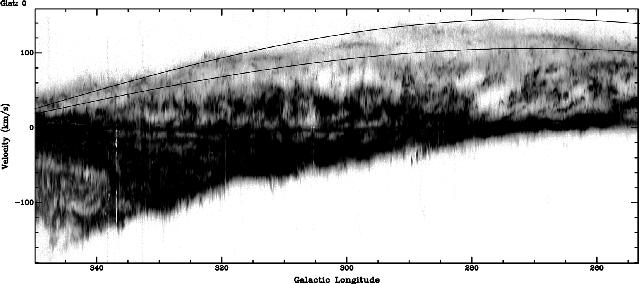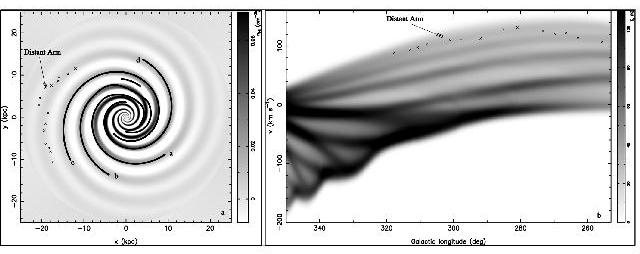A "new" spiral arm for the Milky Way?
The structure of the outer disk of the Milky Way has long been a mystery to Galactic astronomers. Though we know that the neutral hydrogen (HI) disk extends far beyond the stellar disk, we know very little about its structure in this Galactic "outback". In particular, we do not know how far the HI spiral structure of the Galaxy extends.
As part of the Southern Galactic Plane Survey (SGPS; McClure-Griffiths et al. 2001) we have recently identified a remarkable structure in the far outer disk of the southern Milky Way. This structure, shown near the top of Figure 1, is a ridge of emission lying at the far positive-velocity edge of the SGPS longitude-velocity (l-v) diagram. The l-v diagram shows HI emission in the Galactic mid-plane (b = 0°). Emission at negative velocities is interior to the solar circle and corresponds to gas at two distances, whereas emission at positive velocities lies exterior to the solar circle and generally corresponds to only one distance with larger velocities at larger distances. The new ridge of emission arcs from l = 253°, v = 102 km s-1 through l = 299°, v = 110 km s-1 to l = 321°, v = 88 km s-1.

Figure 1: HI longitude-velocity (l-v) diagram of the Southern Galactic Plane showing the outer arm. The arm is observed as a ridge of emission at the most extreme positive velocities. The image has an angular resolution of 2 arcmin, a spectral resolution of 0.8 km s-1, and uses a square-root transfer function from 1 to 70 K. The solid lines are at constant Galactocentric radii of 16 and 24 kpc. (From McClure-Griffiths et al. 2004).
It is relatively cohesive across more than 70 degrees on the sky, kinematically distinct from its surroundings, and is notably the last feature before the edge of the Galactic disk. Overlaid on Figure 1 are lines of constant Galactocentric radius at 16 and 24 kpc, which show that the feature extends from a radius of Rg ~ 17 kpc at the low-longitude end to Rg ~ 25 kpc at the high-longitude end, with an estimated radial width of ~ 2 kpc. The scale height of this feature is relatively constant along its entire length, varying between extremes of 1.2 and 1.7 kpc. We estimate the HI number-density along the mid-plane is 4 × 10-2 cm-3, and by integrating over the z-height we find that the average surface-density is 3 × 10-3 Msun pc-2. Based on the z-height and velocity width of the feature we estimate that a disk density of 6 × 10-3 Msun pc-3 would be required to confine the scale-height of the feature, though there is no evidence that the stellar disk extends to such large Galactocentric radii.
A ridge in the longitude-velocity diagram can be caused by two main physical effects: a gas density enhancement or a significant velocity perturbation that causes gas at different distances to appear at the same velocity. A spiral arm produces a combination of these effects. Spiral arms typically produce only small (nominally a factor of two) HI-density enhancements in the HI disk, but they also induce strong (~10 km s-1) non-circular velocities, or streaming motions, where gas interior to an arm is pulled radially by the arm's gravity. Because the observed feature is not at a constant Galactocentric radius and appears to be radially confined, we hypothesised that it might be a very distant spiral arm. To test this theory we first needed to understand the shape of a spiral arm in l-v space. We created a simple four-arm spiral model for the Milky Way with a pitch angle, i, that varies linearly from 16° at Rg = 4.25 kpc to 10° at Rg = 18 kpc. Using the spiral model and accounting for streaming motions around the spiral arms, we created synthetic HI spectra and constructed a synthetic l-v diagram. The face-on spiral model and synthetic l-v diagram are shown in Figure 2. The model is by no means definitive, but it does recreate many of the dominant features of the observed l-v diagram. In particular, the synthetic l-v diagram also shows a narrow ridge of emission at the most positive velocities. From our model we can show that this ridge maps to the spiral arm in the face-on diagram that passes through (x, y) = (-18 kpc, 6 kpc).
 Figure 2: Left. Differential HI density (spiral perturbation minus the underlying Toomre disk) for a simple four-arm Milky Way spiral model. The Sun is at (x,y) = (0 kpc, 8.5 kpc). Overlaid in solid lines is the spiral model of Cordes & Lazio (2002). Right. Synthetic l-v diagram created from the spiral pattern in the left panel. The proposed distant arm in the right panel maps to a ridge of emission at far positive velocities, as marked. (From McClure-Griffiths et al. 2004)
Figure 2: Left. Differential HI density (spiral perturbation minus the underlying Toomre disk) for a simple four-arm Milky Way spiral model. The Sun is at (x,y) = (0 kpc, 8.5 kpc). Overlaid in solid lines is the spiral model of Cordes & Lazio (2002). Right. Synthetic l-v diagram created from the spiral pattern in the left panel. The proposed distant arm in the right panel maps to a ridge of emission at far positive velocities, as marked. (From McClure-Griffiths et al. 2004)
Though the observed feature can be easily explained by a spiral arm, we also considered a number of other explanations. In particular, we considered whether it might be the result of a pile-up in velocity space at the projection of the Local Standard of Rest onto the line-of-sight from a very extended, smooth HI disk or the signature of elliptical gas-orbits in the outer Galaxy. However, none of these explanations fit the data and we therefore concluded on the basis of agreement with the spiral model that the feature is best described as a spiral arm with a pitch angle of i ~ 9°.
Another notable characteristic of this feature is that it shifts in velocity by about 10 km s-1 between longitudes l = 275° and 295°, as seen in Figure 1. It is interesting that these longitudes agree well with the Galactic longitudes of the Large and Small Magellanic Clouds and the Leading Arm of the Magellanic Stream. In models of the orbits of the Magellanic Clouds, the Clouds should cross the Galactic plane around l = 280°. We might expect that the relative proximity of the Clouds would produce a significant dynamical effect on the outer Milky Way disk. Some models, such as Weinberg (1995), even estimate that the orbit of the LMC should produce a radial shift in the HI at 18 kpc of about 10 km s-1. The observed shift in the outer arm may be that effect.
There is still a great deal to understand about this most distant spiral arm in the Milky Way. For example, it remains to be seen whether there are any stars associated with the arm. In the future we also hope to search for evidence of star formation in the arm. Recent results from the NANTEN telescope in Chile have revealed some 12CO emission at coincident positions in the low-longitude end of the arm (Nakagawa et al., 2004). It is too early to say whether this gas might have formed stars. We also hope that future work will be able to determine whether this feature connects with any other previously known spiral features, as it appears to in our simple model.
References
Cordes, J. M., Lazio, T. J. W. 2002, preprint (astro-ph/0207156)
McClure-Griffiths, N. M., Dickey, J. M., Gaensler, B. M., Green, A. J. 2004, ApJ, 607, L127
McClure-Griffiths, N. M., Green, A. J., Dickey, J. M., Gaensler, B. M., Haynes, R. F., Wieringa, M. H. 2001, ApJ, 549, 959
Nakagawa, M. et al., 2004, ApJ, submitted.
Weinberg, M. D. 1995, ApJ, 455, L31
N. M. McClure-Griffiths, J. M. Dickey, B. M. Gaensler and A. J. Green
(Naomi.McClure-Griffiths@csiro.au)
